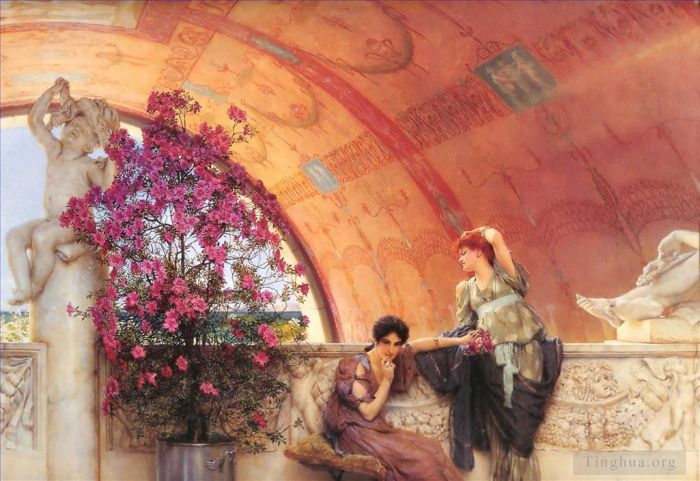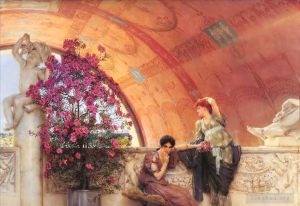Unconscious Rivals
Sir Lawrence Alma-Tadema
- Price: Price on Request
- Art Type: Oil Painting
- Size:
- English Comments: 0
- International Comments: 0
- Creating Date:
- Introduction and Works of Sir Lawrence Alma-Tadema >>
Keywords:
Unconscious, Rivals
Work Overview
- Unconscious Rivals
Sir Lawrence Alma-Tadema
Date: 1893
Style: Romanticism
Genre: genre painting
Media: oil on panel
45 × 63 cm
Location: Bristol City Museum and Art Gallery, Bristol, UK
Alma-Tadema's female figures have a slightly bored pleasure-seeking attitude, as if they were pampered courtesans. There is little action in Alma-Tadema's paintings; here the two women are just probably waiting for a lover. The composition is balanced by the flowers in bloom.
Unconscious Rivals is an example of artist Sir Lawrence Alma-Tadema’s interest in depicting a romanticized (and, it should be noted, very Victorian) interpretation of ancient Rome. And while the setting of this painting - with its magnificently decorated barrel vault in the background - does not conform to any existing Roman models, Lawrence Alma-Tadema has succeeded in creating an atmosphere that evokes the splendor of Rome quite beautifully.
The meaning and significance of the painting’s title are not immediately obvious, but one can guess that the artist is referring to the idea that the two women represented in the work are somehow rivals for the attention of an unseen lover. However, the details in Unconscious Rivals are revealing. On the far left there is a statue of Cupid (known to the ancient Greeks as Eros) that is based on a sculpture from the Capitoline Museum in Rome. Cupid is of course the Roman god of love and desire, so the inclusion of this statue suggests love and its abundant pleasures.
In addition to Cupid, there is also a subtle reference to something with which ancient Romans were intimately familiar - gladiators and the gladiatorial games. For on the right side of the painting there is a partially visible statue that portrays a reclining gladiator. Virile gladiators were often the celebrities of the day, and they were much adored especially by female aristocrats. It is therefore possible that Lawrence Alma-Tadema was hinting at a love triangle involving the pair of women and a handsome gladiator.
An example of Alma-Tadema's meticulous painting style, which, as the exhibition shows, improved with age, [this painting] depicts a scene bathed in an orange light. This is set off by pink flowers, and falls on two Patrician women lounging in a villa whilst perhaps awaiting the return of a (shared?) male lover: the Cupid sculpture here further reflects love and dalliance. But the expressions of the women are hard to decipher. The reason for their rivalry is only hinted at by the sculpted gladiator foot which breaks through from the right-hand edge of the frame. The full sculpture remains out of sight, like the true reason for their rivalry.
Alma-Tadema and [his second wife] Laura spent much time travelling and many of his works, including Unconscious Rivals, draw upon examples of colour and sculpture which he had seen in Roman museums, photos of which were in his collection. The couple also travelled to Pompeii in the 1890s and Alma-Tadema saw the progress of excavations there and took great interest in them, visiting the site daily. Prettejohn argues that this particular painting's legibility is fragmented, with the fragment of the large sculpture making it more so — as Joanna Paul suggests (116). Such fragmentation and consequent lack of comprehensibility is part of what makes Alma-Tadema's works easy to skip past, but it is also part of what brings the viewer back to them. There is something intriguing and inviting, something within the paintings which is unsaid and cannot ever be resolved.
- Copyright Statement:
All the reproduction of any forms about this work unauthorized by Singing Palette including images, texts and so on will be deemed to be violating the Copyright Laws.
To cite this webpage, please link back here.
- >> English Comments
- >> Chinese Comments
- >> French Comments
- >> German Comments
- >>Report
- Death of the Pharaohs Firstborn Son
- A Pyrrhic Dance
- Summer Offering Young Girl with Roses
- Between Venus and Bacchus
- A Roman Emperor AD41detail1
- Portrait of Ignacy Jan Paderewski
- Portrait Of Mrs Charles Wyllie
- The Massacre of the Monks of Tamond
- Pandora
- Who is it
- Egyptian juggler
- A Family Group
- The Death of Hippolytus
- A reading from homer detail
- A world of their own
- The Crossing of the River Berizina 1812
- A Hearty Welcome
- In the Temple Opus 1871
- The Flower Market
- A Roman Art Lover2
- The Sculptors Model
- Ask me no more
- In My Studio
- Expectations
- Welcome footsteps
- A Bath An Antique Custom
- A Declaration
- Portrait of a Woman
- Autumn Vintage Festival
- Ave Caesar Io Saturnalia
- Spring Flowers
- Unwelcome Confidences
- The Picture Gallery
- A Roman Emperor
- Boating
- Caracalla and Geta
- The voice of spring
- The Finding of Moses 1904
- Shy
- A votive offering
- A Harvest Festival A Dancing Bacchante at Harvest Time
- Thou Rose of all the Roses
- Portrait of Aime Jules Dalou his Wife and Daughter
- Flora Spring in the Gardens of the Villa Borghese
- The Sculpture Gallery detail
- A Collection of Pictures at the Time of Augustus
- Prose
- A Difference of Opinion
- A Silent Greeting
- Caracalla
- The Potter
- Poetry
- Confidences
- Maria Magdalena
- Golden hour
- Phidias Showing the Frieze of the Parthenon
- A Listner
- Exhausted Maenides after the Dance
- Interrupted
- The Vintage Festival
- Master John Parsons Millet
- A greek woman
- Proclaiming Claudius Emperor
- Flag Of Truce
- Between Hope and Fear
- The Drawing Room at Townshend House
- Venantius Fortunatus Reading His Poems to Radegonda VI
- Portrait Of Miss Laura Theresa Epps
- Strigils and sponges
- Always Welcome
- Drawing Room Holland Park
- Self Portrait
- Pastimes in Ancient Egyupe 300Years Ago
- The Coliseum
- The Roses of Heliogabalus
- Miss Alice Lewis
- Sunshine
- The years at the spring
- Agrippina with the ashes of Germanicus Opus XXXVII
- Interior of Caius Martiuss House
- A reading from homer
- Joseph Overseer of the Pharoahs Granaries
- Tibullus at Delias
- God Speed
- Midday Slumbers
- The Roman Wine Tasters
- Hadrian Visiting a Romano British Pottery
- A Roman Art Lover
- British 18361912A Roman Scribe Writing Dispatches
- On the Road to the Temple of Ceres
- In the Peristyle2
- Faust and Marguerite
- The Baths of Caracalla
- The parting kiss
- Sappho and Alcaeus
- Interior of the Church of San Clemente Rome
- Sculptors in Ancient Rome
- Egyptian Chess Players
- Sir Lawrence From An Absent One
- A Dedication to Bacchus
- Preparation in the Colosseum detail
- Vain Courtship
- Preparation in the Colosseum
- Mrs George Lewis and Her Daughter Elizabeth
- Dolce Far Niente
- Loves Jewelled Fetter
- A Picture Gallery
- When Flowers Return
- Courtship
- A Favourite Custom
- Maurice Sens
- The Favourite Poet
- Tarquinius Superbus
- Unconscious Rivals
- The Sculpture Gallery
- Architecture in Ancient Rome
- Hopeful
- Portrait of the Singer George Henschel
- After the audience
- Cherries
- Sir Lawrence The Soldier Of Marathon
- Hero 1898
- The Triumph of Titus
- A Prize For The Artists Corps
- Antony and Cleopatra
- Ninetyfour in the Shade
- The Education of the Children of Clovis
- The Frigidarium
- Resting
- Silver Favourites
- Entrance to a roman theatre
- Gallo Roman Women
- An exedra
- Sir Lawrence An Audience
- Loves Votaries
- Not at home
- The Siesta
- A sculpture gallery
- A Street Altar
- Pottery painting
- The Discourse
- Courtship the Proposal
- Lawrence Bacchanale 1871
- Under the Roof of Blue Ionian Weather
- Xanthe and Phaon
- Leaving Church in the Fifteenth Century
- Summer Offering
- Water Pets
- A Birth Chamber
- Portrait of Anna Alma Tadema
- In the Tepidarium
- Pleading
- The Soldier of Marathon
- This is our Corner Laurense and Anna Alma Tadema
- Whispering Noon
- Catullus at Lesbias
- The Way to the Temple
- The Honeymoon
- The Conversion Of Paula By Saint Jerome
- An earthly paradise
- Preparations for the Festivities
- Promise of spring
- Comparisons
- An Oleander
- A kiss
- The Family Group
- My Studio
- The Epps Family Screen
- In the Time of Constantine
- Lesbia Weeping over a Sparrow









 Singing Palette
Singing Palette